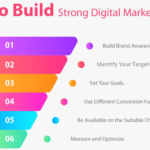
Red Ocean Strategy In E-Commerce: How To Stay Ahead Of Competitors
In India’s e-commerce world, businesses face tough challenges from saturated markets and fierce competition. The red ocean strategy offers a way to succeed by making your products stand out, cutting costs, and beating competitors. This guide will show you how to use the red ocean strategy in your e-commerce business.
The red ocean strategy is a well-known business approach that aims to gain a unique edge in crowded markets. It helps you understand how to deal with market saturation and undifferentiated products. By doing so, you can avoid price wars and ensure long-term profits. For e-commerce businesses in India, mastering the red ocean strategy is key to standing out in the cutthroat competition.
Understanding the Red Ocean Strategy
In today’s e-commerce world, businesses face a crowded market with many similar products. This is where the red ocean strategy helps. It’s about competing in markets where products are mostly the same.
Companies in these “red oceans” battle for a piece of the pie, often leading to low prices and thin profit margins. Yet, for online stores, this strategy is key to finding a unique spot and staying profitable.
What is the Red Ocean Strategy?
The red ocean strategy is about competing in markets that are already crowded. It’s about beating rivals to get a bigger part of the demand. Companies offer similar products but try to stand out with their prices, marketing, or how they operate.
Why is it Relevant in E-Commerce?
In e-commerce, products can easily become the same, making it hard to stand out. The red ocean strategy helps businesses deal with this. By understanding the competition, online stores can create strategies to be noticed, stay profitable, and succeed in the red ocean.

Challenges of Operating in Red Ocean Markets
Running a business in crowded e-commerce markets is tough. These markets are full of market saturation, with many companies offering the same product. This makes it hard for businesses to be unique. The price wars that start can lead to very low prices, hurting profit margins. This makes it hard for e-commerce businesses to grow and make money over time.
Market Saturation and Undifferentiated Products
E-commerce markets are often full of choices. Many companies offer similar products or services. This makes it hard for businesses to stand out and offer something special to customers. When products or services are the same, it becomes a fight over price. This leads to more competition and lower profit margins.
Intense Price Competition and Margin Erosion
The competition in red ocean markets often turns into a never-ending price war. Companies try to beat each other by offering lower prices. This can quickly reduce profit margins, making it hard for e-commerce businesses to keep going and grow. Keeping a business profitable is a big challenge in such a tough market.
| Challenge | Impact |
|---|---|
| Market Saturation | Difficulty in differentiation and standing out from the competition |
| Undifferentiated Products | Intense price competition and a race to the bottom |
| Price Wars | Erosion of profit margins, making it challenging to sustain long-term growth |
| Margin Erosion | Difficulty in maintaining profitability and investing in business development |

Red Ocean Strategy: Cutthroat Rivalry and Competitive Advantage
The red ocean strategy shows us the tough side of cutthroat competition. Yet, it also helps businesses find a way to stand out and win. By understanding the red ocean, e-commerce companies can make their products unique, cut costs, and beat their competitors. This helps them make a profit in a crowded market.
The red ocean strategy says that in a crowded market, companies fight hard for customers. To win, they need to think outside the box and challenge old ways. This means:
- Delivering unique product features or services
- Optimizing operational efficiency to undercut rivals on price
- Providing exceptional customer experiences that foster loyalty and advocacy
By using a red ocean strategy, e-commerce companies can survive the tough cutthroat competition. They can become leaders by being different, offering low prices, and focusing on what customers want. This way, they can make a spot in the market that’s hard for others to take.
| Key Strategies for Red Ocean Success | Benefits |
|---|---|
| Differentiation | Stands out from the competition, creates unique value |
| Cost Leadership | Undercuts rivals on price, maintains profitability |
| Customer Experience | Fosters loyalty, advocacy, and repeat business |

Differentiation Strategies for E-Commerce Businesses
In the world of e-commerce, it’s key to stand out. To succeed, e-commerce businesses need to be different from others. They should focus on product innovation and exceptional customer service and experience.
Product Innovation and Unique Value Propositions
Creating unique products is a great way to be different. By offering products with special features or designs, you grab the attention of customers. This makes your brand a leader in the market.
It’s important to know what your customers want and need. Use market research and customer feedback to inspire new products. This way, you can make products that really speak to your customers.
Exceptional Customer Service and Experience
Great customer service is also key to standing out. By offering personalized and quick support, you build a loyal customer base. This makes your business unique.
- Offer personalized recommendations and assistance to create a tailored shopping experience.
- Ensure prompt and efficient order fulfillment and hassle-free returns or exchanges.
- Maintain open communication channels and promptly address customer inquiries and concerns.
- Leverage data and analytics to continuously optimize and enhance the customer journey.
By focusing on customer service, e-commerce businesses can gain a strong edge. They build lasting relationships with their customers.

Branding and Marketing in a Red Ocean
In today’s crowded e-commerce world, having a strong brand identity is key to standing out. With the right branding and marketing strategies, your company can make a mark. This makes your brand memorable and connects with your audience, giving you an edge over competitors.
Building a Strong Brand Identity
Creating a strong brand identity is more than just a cool logo or slogan. It’s about making a unique brand experience that touches every part of your business. This includes your website, social media, customer service, and even your product packaging.
Here are some key elements to consider for a strong brand identity:
- Visual Branding: Make sure your logo, colors, and look are nice and consistent everywhere.
- Brand Messaging: Have a clear message that shows what you offer and what makes you different.
- Brand Personality: Create a brand personality that speaks to your audience and shows off your values and mission.
- Consistent Customer Experience: Give customers a smooth and great experience that matches your brand at every touchpoint.

Cost Leadership and Operational Efficiency
To succeed in e-commerce, businesses must stand out and focus on keeping costs low and running efficiently. They can do this by making their supply chain and logistics better and using technology more. This helps cut costs and boosts productivity.
Streamlining Supply Chain and Logistics
For e-commerce companies, making their supply chain and logistics better is key to staying ahead. They can do this by managing their inventory well, making sure orders are filled quickly, and finding the best ways to transport goods. These steps help lower costs and make things run smoother.
- Implement advanced inventory management systems to minimize waste and optimize stock levels
- Optimize order fulfillment processes to reduce delivery times and shipping costs
- Leverage data analytics to optimize transportation routes and modes, reducing fuel consumption and carbon footprint
Leveraging Technology and Automation
The e-commerce world is changing fast, thanks to new technology. Companies that use these changes well can get ahead. By automating tasks and making things run smoother, they can lead in costs and efficiency.
| Technology | Benefits |
|---|---|
| Robotics and Warehouse Automation | Increased productivity, reduced labor costs, and improved accuracy |
| Automated Order Processing and Fulfillment | Faster turnaround times, reduced errors, and enhanced customer satisfaction |
| AI-powered Demand Forecasting | Improved inventory management, reduced waste, and better resource planning |
By using technology and automation well, e-commerce companies can find the right balance. This balance is key to being a leader in costs and efficiency. It gives them a big edge in the competitive market.

Niche Marketing and Targeted Segments
Focusing on niche marketing and targeted segments is key to success. By finding customer groups that are not well-served, you can stand out. This way, you don’t compete directly with big companies.
Niche marketing means really getting to know what a certain group of customers likes and needs. You can then make products and campaigns that speak directly to them. This approach helps you stand out and build a loyal customer base.
Targeted segmentation means breaking down your customers into groups based on things like their age, what they like to do, or what they think. This lets you make special offers and messages for each group. This makes your brand more appealing and relevant to them.
| Benefits of Niche Marketing | Benefits of Targeted Segmentation |
|---|---|
|
|
Using niche marketing and targeting specific groups helps e-commerce businesses succeed, even in tough markets. This strategy gives you a unique edge and a clear message for your best customers.

Red Ocean Strategy: Continuous Innovation and Adaptation
In today’s e-commerce world, the competition is fierce. To stand out, you need a strategy of continuous innovation and adaptation. Keep an eye on market changes and what customers want. This way, you can spot new chances and change your business fast.
Being quick and flexible is crucial for e-commerce success. You must always improve your products, services, and how you market them. This helps you meet customer needs and beat the competition.
- Regularly conduct market research to understand shifting consumer trends and pain points.
- Foster a culture of innovation within your organization, empowering employees to explore new ideas and solutions.
- Leverage data-driven insights to inform your decision-making and guide your strategic adaptations.
- Embrace technological advancements that can streamline your operations and enhance the customer experience.
By always thinking about continuous innovation and adaptation, you can thrive in the competitive e-commerce world. Stay alert to market changes and keep improving your plans. This way, you can beat your rivals and grow your e-commerce business.

Strategic Partnerships and Collaborations
In the competitive world of e-commerce, forming strategic partnerships can really help businesses stand out. By working together, you can offer more value to your customers. This happens when you use each other’s strengths and resources well.
Leveraging Complementary Strengths and Resources
Look for businesses that have what you need to make your products better. This could mean working with companies that have:
- Access to different customers or ways to get products to them
- Know-how in areas like logistics, marketing, or tech
- Unique products or services that go well with yours
Together, you can offer something special that makes you stand out. This is key in a crowded market.
For instance, an online fashion store might team up with a shipping company to get products to customers faster. Or, they could work with a brand that makes accessories to create a special line of products together. These partnerships help both companies use their strengths to reach more customers.
| Benefits of Strategic Partnerships | Examples of Successful Collaborations |
|---|---|
|
|
Choosing the right strategic partnerships and using each other’s strengths can really set e-commerce businesses apart. It helps them stand out and succeed in a tough market.

Conclusion
The red ocean strategy is a key way for businesses to lead. By focusing on being different, cutting costs, and always innovating, you can make a unique spot in the market. This approach helps you succeed for a long time.
By innovating your products, giving top-notch customer experiences, and working efficiently, you can stand out in a crowded market. Using data and forming strong partnerships can also help you stay ahead. This makes your business strong and ready to change with the market.
When you’re in the red ocean of e-commerce in India, success comes from always changing, adapting, and giving your customers great value. By using the red ocean strategy, you can make your e-commerce business grow and make more money over time. This will make you a leader in this fast-moving field.
Share this content:


















































Post Comment